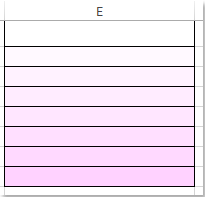Wie wendet man einen Farbverlauf auf mehrere Zellen an?
In Excel können wir ganz einfach eine Hintergrundfarbe in eine Zelle oder mehrere Zellen füllen, aber manchmal möchten wir, dass die Farbe wie im folgenden Screenshot gezeigt als Verlauf gefüllt wird. Wie kann man also einen Farbverlauf in einer Zelle oder über mehrere Zellen hinweg in Excel erreichen?


Farbverlauf auf eine Zelle mit der Funktion „Zellen formatieren“ anwenden
Farbverlauf über mehrere Zellen mit VBA-Code anwenden
 Farbverlauf auf eine Zelle mit der Funktion „Zellen formatieren“ anwenden
Farbverlauf auf eine Zelle mit der Funktion „Zellen formatieren“ anwenden
In Excel kann die Funktion „Zellen formatieren“ Ihnen helfen, einen Farbverlauf in einer Zelle zu füllen. Gehen Sie dazu wie folgt vor:
1. Wählen Sie eine Zelle oder mehrere Zellen aus, die Sie mit einem Farbverlauf füllen möchten, und klicken Sie dann mit der rechten Maustaste, um „Zellen formatieren“ aus dem Kontextmenü auszuwählen. Im Dialogfeld „Zellen formatieren“ klicken Sie unter der Registerkarte Hintergrundfüllung bitte auf die Schaltfläche Fülleffekte. Siehe Screenshot:

2. Wählen Sie im Dialogfeld „Fülleffekte“ zwei Farben aus den beiden Dropdown-Listen im Abschnitt Farben aus, und wählen Sie dann einen Schattierungsstil, der Ihnen gefällt, wie z. B. horizontal, vertikal usw. Siehe Screenshot:

3. Klicken Sie dann auf OK > OK, um die Dialogfelder zu schließen, und der Farbverlauf wird wie im folgenden Screenshot gezeigt für jede Zelle gefüllt:


Entfesseln Sie die Magie von Excel mit Kutools AI
- Intelligente Ausführung: Führen Sie Zellenoperationen durch, analysieren Sie Daten und erstellen Sie Diagramme – alles angetrieben durch einfache Befehle.
- Benutzerdefinierte Formeln: Erstellen Sie maßgeschneiderte Formeln, um Ihre Arbeitsabläufe zu optimieren.
- VBA-Codierung: Schreiben und implementieren Sie VBA-Code mühelos.
- Formelinterpretation: Verstehen Sie komplexe Formeln mit Leichtigkeit.
- Textübersetzung: Überwinden Sie Sprachbarrieren in Ihren Tabellen.
 Farbverlauf über mehrere Zellen mit VBA-Code anwenden
Farbverlauf über mehrere Zellen mit VBA-Code anwenden
Die obige Methode kann uns helfen, einen Farbverlauf innerhalb einer einzelnen Zelle zu erstellen. Wenn Sie jedoch einen Farbverlauf über mehrere Zellen hinweg schattieren müssen, müssen Sie einen VBA-Code verwenden, um dies zu lösen.
1. Füllen Sie zunächst eine bestimmte Hintergrundfarbe in einen Zellbereich ein.
2. Halten Sie die Tasten ALT + F11 gedrückt, um das Fenster Microsoft Visual Basic for Applications zu öffnen.
3. Klicken Sie auf Einfügen > Modul und fügen Sie den folgenden Code in das Modulfenster ein.
VBA-Code: Farbverlauf über mehrere Zellen anwenden:
Sub colorgradientmultiplecells()
'Updateby Extendoffcie
Dim xRg As Range
Dim xTxt As String
Dim xCell As Range
Dim xColor As Long
Dim I As Long
Dim K As Long
Dim xCount As Long
On Error Resume Next
If ActiveWindow.RangeSelection.Count > 1 Then
xTxt = ActiveWindow.RangeSelection.AddressLocal
Else
xTxt = ActiveSheet.UsedRange.AddressLocal
End If
LInput:
Set xRg = Application.InputBox("please select the cells range:", "Kutools for Excel", xTxt, , , , , 8)
If xRg Is Nothing Then Exit Sub
If xRg.Areas.Count > 1 Then
MsgBox "does not support multiple selections", vbInformation, "Kutools for Excel"
GoTo LInput
End If
On Error Resume Next
Application.ScreenUpdating = False
xCount = xRg.Rows.Count
For K = 1 To xRg.Columns.Count
xColor = xRg.Cells(1, K).Interior.Color
For I = xCount To 1 Step -1
xRg.Cells(I, K).Interior.Color = xColor
xRg.Cells(I, K).Interior.TintAndShade = (xCount - (I - 1)) / xCount
Next
Next
End Sub
4. Drücken Sie dann die Taste F5, um diesen Code auszuführen, und es erscheint ein Eingabefeld, das Sie auffordert, die farbigen Zellen auszuwählen, die Sie mit einem Farbverlauf füllen möchten. Siehe Screenshot:

5. Klicken Sie anschließend auf die Schaltfläche OK, und die Farbe innerhalb der mehreren Zellen wird als Farbverlauf angezeigt. Siehe Screenshot:

Die besten Produktivitätstools für das Büro
Stärken Sie Ihre Excel-Fähigkeiten mit Kutools für Excel und genießen Sie Effizienz wie nie zuvor. Kutools für Excel bietet mehr als300 erweiterte Funktionen, um die Produktivität zu steigern und Zeit zu sparen. Klicken Sie hier, um die Funktion zu erhalten, die Sie am meisten benötigen...
Office Tab bringt die Tab-Oberfläche in Office und macht Ihre Arbeit wesentlich einfacher
- Aktivieren Sie die Tabulator-Bearbeitung und das Lesen in Word, Excel, PowerPoint, Publisher, Access, Visio und Project.
- Öffnen und erstellen Sie mehrere Dokumente in neuen Tabs innerhalb desselben Fensters, statt in neuen Einzelfenstern.
- Steigert Ihre Produktivität um50 % und reduziert hunderte Mausklicks täglich!
Alle Kutools-Add-Ins. Ein Installationspaket
Das Kutools for Office-Paket bündelt Add-Ins für Excel, Word, Outlook & PowerPoint sowie Office Tab Pro und ist ideal für Teams, die mit mehreren Office-Anwendungen arbeiten.
- All-in-One-Paket — Add-Ins für Excel, Word, Outlook & PowerPoint + Office Tab Pro
- Ein Installationspaket, eine Lizenz — in wenigen Minuten einsatzbereit (MSI-kompatibel)
- Besser gemeinsam — optimierte Produktivität in allen Office-Anwendungen
- 30 Tage kostenlos testen — keine Registrierung, keine Kreditkarte erforderlich
- Bestes Preis-Leistungs-Verhältnis — günstiger als Einzelkauf der Add-Ins